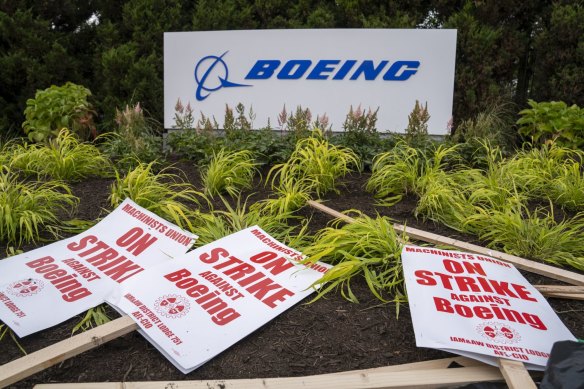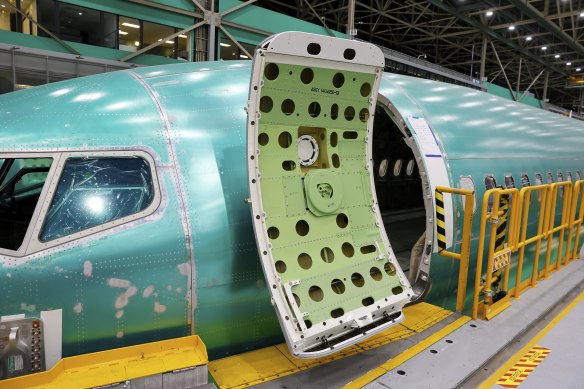
That’s why there are suggestions that Boeing’s fixed price contracts with the US Defence Department might be renegotiated.
The bulk of those contracts were entered into before the pandemic upended supply chains and sparked a massive surge in the US inflation rate that rendered them unprofitable.

A continuing strike is just one of many problems for Boeing.Credit: Bloomberg
Boeing lost $US2.4 billion in its defence, space and security division in the September quarter. That’s unsustainable, and the pressure on the US government to help bail Boeing out by putting profit back into those contracts is obvious.
The national economic and security implications of Boeing’s financial predicament are why its bankers and shareholders would be prepared to lend or invest new money in what would otherwise be a failing enterprise. They know Boeing won’t be allowed to fail.
The $US10 billion credit facility that a consortium of America’s largest banks arranged relieves near-term liquidity pressures and, by assuaging concerns about Boeing’s survival and demonstrating the support of its banks, should make it easier to raise the massive infusions of new equity and debt its SEC filing envisages.
If Boeing can raise fresh equity, it might also avert the threat of a ratings downgrading that would exclude most of its $US50 billion-plus of long-term debt from investment-grade indices. Some institutions can’t hold anything other than investment-grade debt. A downgrade would restrict the company’s access to debt and add to its cost.
Boeing’s new chief executive, Kelly Ortberg, has made it clear that retaining its investment grade status – avoiding having its debt classified as junk debt – is a priority.
The rate at which Boeing is burning cash is an outcome of its deeper problems. The crashes of its planes and other incidents – like the door that fell off during a take-off in January – revealed major quality control failures in its production processes, and have resulted in a massive blowout in its ability to deliver planes to its customer airlines.
On Friday, Boeing said deliveries of its 777X model would be further delayed, to 2026. First deliveries of the plane, Boeing’s largest wide body aircraft, were originally scheduled to occur in 2019.
Boeing’s failings have caused chaos for its customers and their fleet planning, forcing them to spend heavily to update existing aircraft to extend the lives of their fleets while they wait – and wait – for Boeing to meet its contractual commitments.

Boeing has a backlog of orders for almost 5500 planes, with estimates that there is about $US500 billion of revenue trapped in those delayed deliveries.Credit: AP
Airlines like Emirates, Singapore, Qatar and Lufthansa are all in the queue for the 777s – Emirates alone has ordered more than 200 planes. In fact, Boeing has a backlog of orders for almost 5500 planes, with estimates that there is about $US500 billion of revenue trapped in those delayed deliveries.
Airbus has benefited from Boeing’s woes, but doesn’t have the capacity to capitalise significantly on the opportunity the problems have presented.
It’s also had some production issues of its own, and has lowered its aircraft production target for 2024 from 800 to 770, citing supply chain disruptions. It will struggle to meet even that reduced target. Airbus, too, has a swelling backlog of orders.
Loading
China’s Comac, whose narrow-bodied jets flew commercially for the first time last year, has global ambitions and is part of China’s five-year plans to dominate particular advanced manufacturing sectors.
But Comac is heavily reliant on US and European suppliers for key components, and lacks the international networks of parts and service centres of Boeing and Airbus, which aren’t easily or quickly replicated. China’s ambitions are long-term.
Thus, Boeing’s problems – which most blame on its acquisition of McDonnell Douglas in 1997 and its adoption of that company’s emphasis on profit over engineering excellence and safety – are an industry-wide problem.
Airlines have nowhere else to go and therefore no option but to refurbish their existing ageing fleets while waiting several more years, at least, for their new planes.
The Business Briefing newsletter delivers major stories, exclusive coverage and expert opinion. Sign up to get it every weekday morning.









 Add Category
Add Category